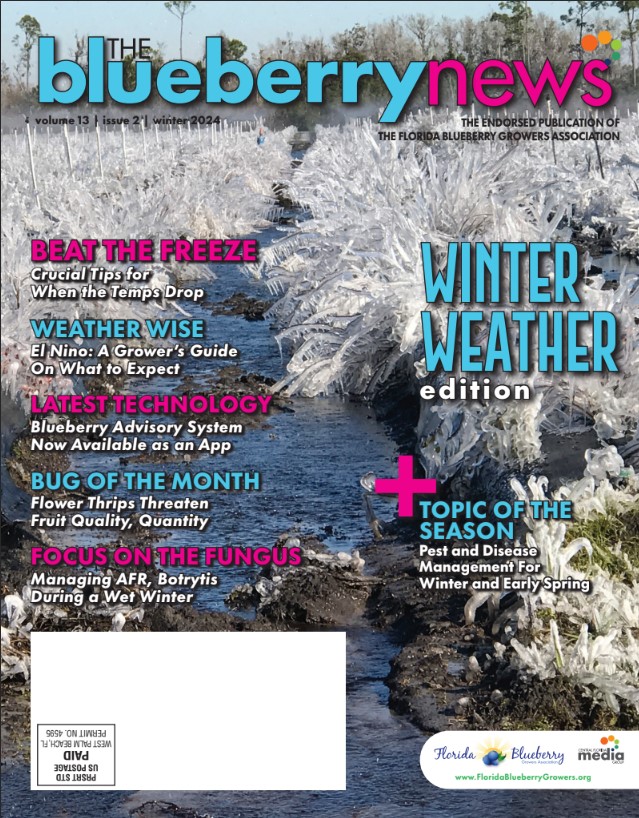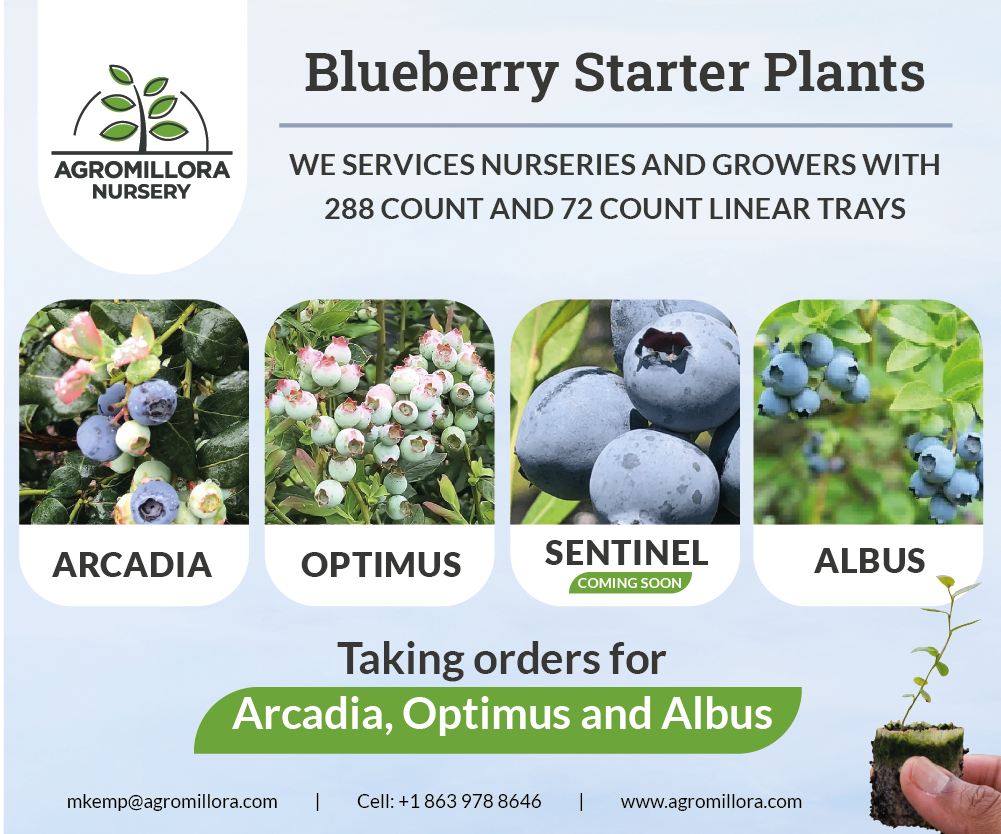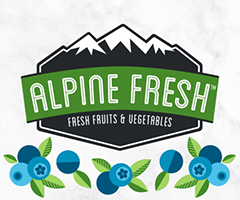Fall and Winter Are Deceptively Important in Florida Blueberry Fields
Credits: Jeffrey G. Williamson, Professor, Horticultural Sciences Department, University of Florida
& Doug Phillips, Blueberry Extension Coordinator, University of Florida
With the onset of the fall and winter seasons, many changes are taking place in blueberry fields, including physiological changes in the plants and management changes in fertilization and irrigation practices. Flower bud initiation and development are important processes occurring now (although not readily apparent) that will likely have a direct effect on berry yields the following year. The first indications of flower bud initiation are usually visible (with the aid of a microscope) during late August for some cultivars, or in September for others.
One study conducted at the Plant Science Research and Education Unit (PSREU) in Citra showed differences between “Emerald” and “Jewel” in the timing of flower bud primordia development. For “Emerald” a significant number of buds contained floral structures by early September. However, for “Jewel,” buds with floral structures were not found until October. In both cases, the number of buds with floral structures continued to increase through the final measuring date of mid-November.
In general, flower bud initiation and development is believed to continue throughout the fall and early winter. Certain environmental conditions are needed for these processes to occur satisfactorily. Shorter day lengths combined with cooler night temperatures are important environmental cues that initiate the onset of dormancy (in deciduous production) and stimulate flower bud initiation in many crops, including blueberry. A study conducted at the University of Florida demonstrated that short day lengths (long uninterrupted dark periods) combined with cool temperatures stimulated greater flower bud development in southern highbush blueberry (SHB) (Table 1).
Table 1. Effect of temperature and photoperiod on flower bud number per plant of ‘Misty’ southern highbush blueberry.
|
Temperature |
||
|
Photoperiod |
21 (C) |
28 (C) |
|
Short day + night interrupt1 |
0.6b |
0.0b |
|
Short day2 |
38.0a |
8.6b |
18-hour photoperiod followed by 16-hour dark period.
28-hour photoperiod followed by 16-hour dark period with one hour of light interrupt.
From Timothy M. Spann. 2001. Environmental influences on flower bud initiation in Vaccinium species. Thesis. University of Florida.
Table 1 clearly shows the importance of photoperiod and temperature on flower bud development in “Misty” SHB. Note that a short photoperiod was a requirement for flower bud development and high temperature (28 Co) had a strong inhibitory effect on flower bud development, even under short photoperiod conditions. Although “Misty” is no longer commonly grown, these traits appear to be common to most, if not all, SHB cultivars.
Research at UF has also demonstrated that healthy leaves are needed during the processes of flower bud initiation and development. Figure 1 shows the effects of removing leaves early in the fall (September) vs maintaining healthy leaves throughout the fall (until December). Not only were there more flower buds, but the flower buds were more completely developed (individual buds contained more florets) when healthy leaves were present throughout the fall, versus when leaves were removed in early fall. In this study, leaves were manually removed at various times, but one can imagine that early fall defoliation from one of several leaf spot diseases could have a similar deleterious effect on flower bud initiation and development. Summer pruning, leaf disease and pest management, and a sound fertilization/irrigation program are key management practices that lead to healthy fall foliage.
As mentioned earlier, with the onset of fall and winter, blueberry plants enter the early stages of winter dormancy. This is desirable for plants grown under the dormant production system, to protect them from freezing temperatures. Water use by blueberry plants grown under the deciduous production system is known to decline rapidly in the fall as days become shorter, temperatures are cooler, and shoot extension growth stops. In one study at the PSREU, average plant water use declined by about 37% between September (a period of high water use) and October, and declined another 30% between October and November. Growers using the deciduous production system usually find it helpful to stop fertilization in late summer or early fall (date of the last fertilizer application will vary with factors such as location, fertilizer type/formulation, and cultivar) and reduce irrigation as plant water demands decline in the fall, to prepare plants for the oncoming fall and winter seasons. The resulting cessation of shoot extension growth is needed for the onset of dormancy. Once dormant, exposure to cool temperatures will be needed to satisfy the chilling requirement to resume normal spring growth the following year. Often, chilling may be inadequate or only marginally adequate and hydrogen cyanamide (HC) may be used as a dormancy-breaking compound to assist with a strong, uniform, emergence from dormancy. Cultivars respond differently to HC and it should not be used on a particular cultivar if that cultivar’s tolerance to HC is unknown. More information on HC use is available in the 2019 Florida Blueberry Integrated Pest Management Guide (https://edis.ifas.ufl.edu/pdf%5CHS%5CHS38000.pdf).
In areas of Florida where winter chilling is likely to be low, growers have adopted the “evergreen” production system. The main distinction between this system and the deciduous system is that dormancy is avoided with the evergreen system and as a result, there is no related chilling requirement. With the evergreen system, plants maintain their leaves throughout the winter and these leaves are important for early crop development. Typically, the harvest season for evergreen production will begin earlier, be less concentrated, and extend over a longer period than with the deciduous system. With the evergreen system, fall and winter fertilizer and irrigation management will differ from the traditional deciduous production system. While less fertilizer is needed during the fall and winter than during the spring and summer, some maintenance level of fertilization is needed throughout the fall and winter to maintain healthy foliage and prevent dormancy. The evergreen system is relatively new and there are currently no research-based fertilizer recommendations. Similarly, irrigation should be reduced during the fall and winter compared to the summer, but irrigation will be needed in higher quantities than under the deciduous system. This is due to the presence of leaves throughout the winter and warmer temperatures in southern production areas where the evergreen system is most common. For additional information on the evergreen system see Evergreen Production System for Southern Highbush Blueberries in Florida (https://edis.ifas.ufl.edu/pdf/HS/HS136200.pdf).
Along with fertilization and irrigation, another key to successfully using the evergreen system is effective disease and pest control. Fungal leaf diseases, including rust, anthracnose, target spot, and Phyllosticta, can damage foliage and result in defoliation. A good preventive fungicide program, along with scouting and application of suggested fungicides when disease symptoms are observed, will help to maintain healthy foliage. One of the primary fall pests that can result in foliage damage and possible defoliation in Florida is the southern red mite. Mite populations typically peak during early to mid-fall when conditions are hot, dry, and dusty. Regular scouting and application of suggested miticides, along with cultural practices such as applying water to roadways to reduce dusty conditions, can help minimize damage and keep foliage intact. See Florida Blueberry Leaf Disease Guide (https://edis.ifas.ufl.edu/pdf/PP/PP34800.pdf) and Mite Pests of Southern Highbush Blueberry in Florida (https://edis.ifas.ufl.edu/pdf/IN/IN128400.pdf), along with the UF/IFAS Blueberry Growers Guide app, for additional information.
Awareness of the physiological changes in plants during fall and early winter months, along with knowledge of required changes in management practices during this time, will help growers to effectively manage their fields to help promote good production the following spring and good overall plant growth.
Figure 1. Effect of timing of defoliation on flower bud development of ‘Misty’ southern highbush blueberry.





